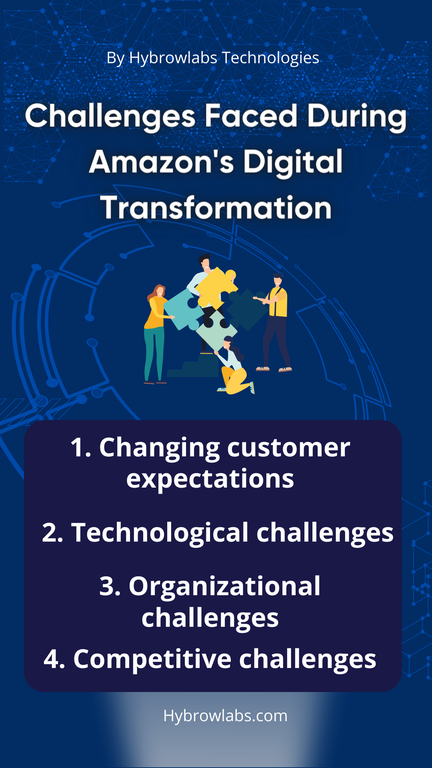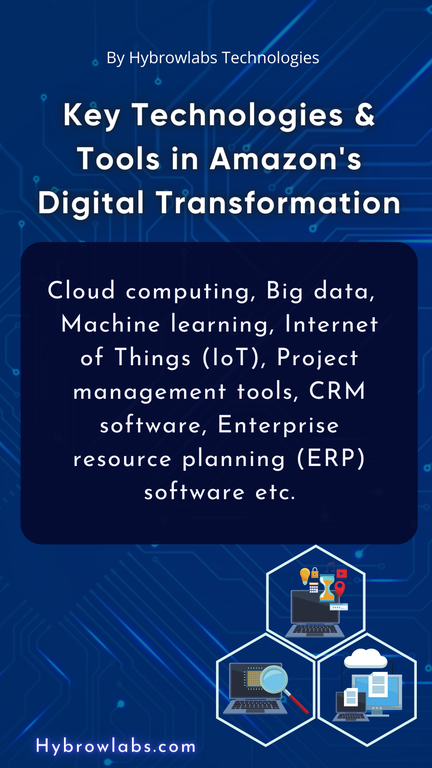Within the rapidly changing digital landscape, Amazon is a prime example of a business that has effectively executed digital transformation. Its constant commitment to customer satisfaction, creative application of big data & artificial intelligence, supply chain optimization, robotics integration, & unmatched scalability have completely changed the e-commerce sector. Examining this Amazon case study in detail will reveal five priceless takeaways from its path that businesses of all sizes may apply. These lectures cover the fundamentals of automation, data-driven decision-making, operational effectiveness & the vital ability to grow & change in a world that is changing quickly. Because of its incredible success, organizations looking to succeed in the digital space can use Amazon as a beacon of light. So let’s discuss deeply what we can learn from Amazon & become successful in business.

5 Lessons From Amazon’s Digital Transformations:
1. Customer Experience:
Customer experience is Amazon's top priority. The company is continually innovating to discover new methods to make the customer experience smoother. For example, Amazon presented a one-click checkout to make it more comfortable for customers to buy products. Amazon also uses artificial intelligence to suggest products to customers based on their previous purchases & browsing history.
Examples of Amazon's customer-centric initiatives:
- Amazon Prime: Amazon Prime is a membership program that offers customers various advantages, including free two-day shipping on millions of things & access to exclusive streaming content.
- Amazon Go: Amazon Go is a chain of cashierless convenience stores where customers can just pick up the items they want & walk out and their purchase will be automatically delegated to their Amazon account.
- Amazon Alexa: Amazon Alexa is a voice assistant that customers can use to shop, play music, get updates & handle their smart home devices.
2. Artificial Intelligence And Big Data:
Artificial intelligence & big data are essential for Amazon's digital transformation. The company uses AI to power its recommendation engine, fraud detection system & customer service chatbots. Amazon also uses big data to analyze customer behavior & trends. This data helps Amazon to improve its products, services & operations.
Examples of Amazon's use of AI & big data in trial:
- Amazon's recommendation engine: Amazon uses AI to suggest products to customers based on their past purchases & browsing history. This helps customers to browse new products that they are likely to be interested in.
- Amazon's fraud detection system: Amazon uses AI to detect & prevent fraudulent transactions. This helps to protect customers & Amazon from financial loss.
- Amazon's customer service chatbots: Amazon uses AI-powered chatbots to answer customer questions & resolve issues. This helps to provide customers with fast & efficient customer support.
3. Supply Chain Optimization:
Supply chain optimization is required for Amazon's success. The company has funded heavily in its supply chain to confirm that it can deliver products to customers quickly & efficiently. Amazon uses AI to optimize its stock levels & shipping lanes.
Examples of Amazon's innovative supply chain optimization initiatives:
- Amazon's predictive inventory management system: Amazon uses AI to predict customer demand & ensure that it has the right products in stock at the right time. This helps to minimize stockouts & overstocking.
- Amazon's dynamic shipping routes: Amazon uses AI to customize its shipping routes based on real-time traffic situations & weather information. This helps to make sure that customers receive their products as fast as possible.
- Amazon's fulfillment center network: Amazon has a network of fulfillment centers all around the world. This allows the company to supply products to customers fast, even if they live in isolated areas.
4. Robotics
Robotics is another key element of Amazon's digital transformation. The company uses robots in its fulfillment centers to pick, pack & ship products. Robotics has helped Amazon to improve the efficiency and accuracy of its fulfillment operations.
Examples of Amazon's use of robots in practice:
- Amazon's robotic pickers: Amazon uses robotic pickers to pick items from warehouse shelves. This helps to speed up the picking process & reduce errors.
- Amazon's robotic packers: Amazon uses robotic packers to pack items into boxes. This helps to improve the accuracy & speed of the packing process.
- Amazon's robotic shippers: Amazon uses robotic shippers to move boxes around its fulfillment centers & load them onto trucks. This helps to enhance the efficiency of the shipping procedure.
5. The ability to Scale
Scalability is important for Amazon's growth. The company has created a scalable infrastructure that can manage millions of transactions per day. Amazon's scalable infrastructure lets the company to grow fast into new markets & launch new products & services.
Examples of Amazon's scalable infrastructure initiatives:
- Amazon Web Services (AWS): AWS is a cloud computing platform that Amazon delivers to businesses & individuals. AWS allows businesses to scale their IT resources up or down as required.
- Amazon's distributed computing platform: Amazon uses a distributed computing platform to manage its huge workload.
Challenges Faced During Amazon's Digital Transformation:

While Amazon's success in digital transformation is indeed remarkable, it's important to acknowledge that their journey was not without challenges. Understanding these challenges can provide valuable insights for organizations embarking on their own digital transformation efforts:
1. Changing customer expectations:
Amazon's customers have come to expect a high level of convenience & service. The company has had to constantly innovate to keep up with these expectations.
2. Technological challenges:
Amazon has had to invest massively in new technologies like artificial intelligence & big data. This has been a challenge in terms of price, time & expertise.
3. Organizational challenges:
Amazon has had to transform its organizational culture & structure to support its digital transformation. This has been a challenge for both employees & managers.
4. Competitive challenges:
Amazon works in a highly competitive industry. The company has had to continually evolve its business model to stay ahead of its rivals.
Here are some specific examples of the challenges that Amazon met during its digital transformation journey:
- When Amazon first launched its online bookstore, it faced the challenge of convincing customers to buy books online. This was a new concept at the time & many people were hesitant to trust their credit card information to an online retailer. Amazon overcame this challenge by offering a number of customer-friendly features, such as free shipping & a generous return policy.
- As Amazon expanded its business into new areas like electronics & apparel, it faced the challenge of building relationships with new suppliers. Amazon had to develop a system for evaluating & onboarding new suppliers & it had to negotiate favorable pricing & terms.
- As Amazon's customer base grew, it faced the challenge of managing its inventory & shipping operations efficiently. Amazon had to develop sophisticated systems for tracking its inventory levels & optimizing its shipping routes.
- As Amazon joined new markets, it faced the challenge of adjusting its business model to regional cultures & rules. For example, Amazon had to learn how to capitulate with different tax laws & labor regulations in various countries.
Amazon has successfully overpowered all of these challenges & it is now one of the most successful businesses in the world. The company's digital transformation has been a critical factor in its victory.
In addition to the challenges listed above, Amazon has also faced challenges like
- Cybersecurity: Amazon is a prime target for cyberattacks & the company has had to invest laboriously in cybersecurity actions to rescue its customers' data.
- Counterfeit goods: Amazon has had to take steps to fight the sale of fake goods on its platform.
- Labor practices: Amazon has been criticized for its toil practices, especially in its fulfillment centers. The company has taken steps to grow its labor practices, but it continues to face scrutiny.
Key Technologies and Tools in Amazon's Digital Transformation:

Amazon's digital transformation success is underpinned by a strategic adoption of various cutting-edge technologies & tools. Understanding these key elements can offer valuable insights into their transformation journey:
1. Cloud computing:
Amazon Web Services (AWS) is Amazon's cloud computing platform. AWS supplies a wide range of services, including computing, storage, networking, databases, analytics, machine learning & artificial intelligence. AWS permits Amazon to raise its IT resources up or down as required & to develop & deploy new applications quickly & efficiently.
2. Big data:
Amazon uses big data to investigate customer manners & trends and to enhance its products, services & processes. Amazon collects data from different sources, including customer purchases, website visits & social media interactions. Amazon then uses this data to generate insights that can be used to grow the customer experience, develop new products & services, and customize operations.
3. Machine learning:
Amazon uses machine learning to develop & improve its AI applications. Machine learning permits Amazon's AI applications to learn from data & improve their implementation over time.
4. Internet of Things (IoT):
Amazon also uses IoT technology to improve its procedures & customer experience. For example, Amazon uses IoT sensors to track the movement of products through its fulfillment centers & to monitor the temperature & humidity in its warehouses.
In addition to these key technologies, Amazon also uses many other tools to sustain its digital transformation. For example, Amazon uses the following:
1. Software development tools:
Amazon uses a variety of software development tools, including Git, Jira & Confluence. These tools help Amazon's developers to build & maintain high-quality software applications.
2. Project management tools:
Amazon uses project management tools, like Asana and Monday.com, to track the progress of its digital transformation projects & to ensure that they are completed on time & within budget.
3. Communication tools:
Amazon uses communication tools, like Slack & Zoom, to facilitate communication & collaboration between its employees.
4. Customer relationship management (CRM) software:
Amazon uses CRM software to manage its customer relationships. CRM software helps Amazon to track customer interactions, identify sales opportunities & provide better customer service.
5. Enterprise resource planning (ERP) software:
Amazon uses ERP software to manage its business processes like accounting, manufacturing & inventory management. ERP software helps Amazon to improve the efficiency & accuracy of its operations.
Conclusion:
Amazon's digital transformation journey serves as a beacon of creation, innovation & adaptability in a heavily evolving digital landscape. As we've explored the five key lessons from Amazon's case study, along with the challenges they encountered & the technologies that fueled their transformation, it's clear that the company's success is not a mere stroke of luck but a result of meticulous planning, strategic execution & relentless commitment to customer satisfaction. If you are looking for a digital transformation tool for your business partner with Hybrowlabs.

FAQ:
1. How did Amazon prioritize customer experience in its digital transformation?
Amazon placed customer satisfaction at the core of its digital transformation efforts by focusing on personalization, user-friendly interfaces & customer feedback. The company's commitment to providing a seamless shopping experience helped build customer loyalty & retention.
2. What role did artificial intelligence and big data play in Amazon's success?
Artificial intelligence & big data were instrumental in Amazon's success. These technologies powered customer recommendations, inventory management & fraud detection, leading to data-driven decision-making & improved operational efficiency.
3. How did Amazon optimize its supply chain through digital transformation?
Amazon optimized its supply chain by implementing real-time inventory management, demand forecasting & logistics efficiency. This streamlined operations reduced costs & enabled faster delivery to customers.
4. What were the key applications of robotics in Amazon's digital transformation?
Robotics played a crucial role in Amazon's warehouses, automating tasks like picking, packing, & inventory management. This automation enhanced speed, accuracy & cost-effectiveness in fulfillment operations.
5. How did Amazon's ability to scale impact its digital transformation journey?
Amazon's ability to scale was supported by its cloud computing platform, Amazon Web Services (AWS). This allowed the company to rapidly expand its operations & innovate, providing the necessary infrastructure & services for growth.



7fe39f.png)


a3dc85.jpg)

.jpg)
fd8f11.png)

.jpg)
.jpg)